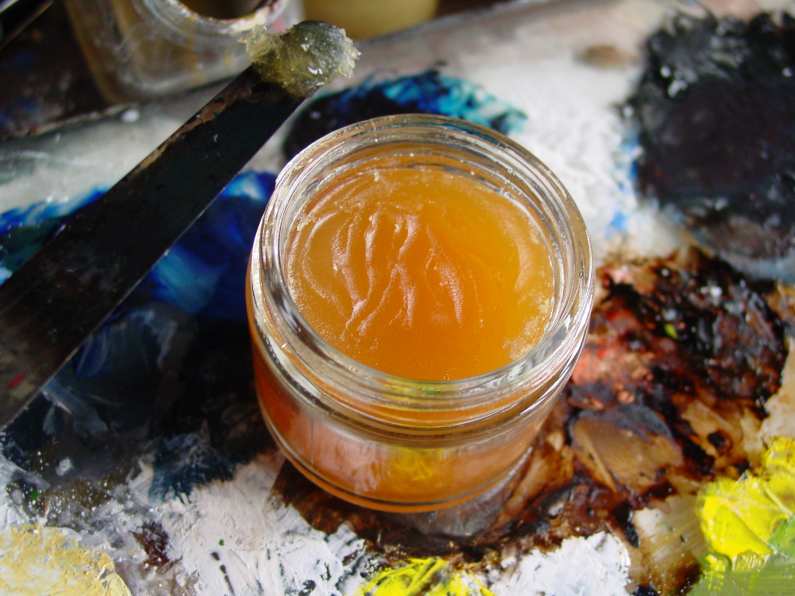
Groves’ Congealed Fir Varnish
Creating an Optical Grisaille and Subsequent Coloring

An "optical grisaille" is my own term for an old painting device which dates back at least to the Italian masters of the late 1400-1500's. For example I've often noticed it in use by various Venetian masters and it may be hinted at in some of Leonardo's unfinished works. I have played with this approach myself through the years. It is a very simple device meant to speed workmanship and provide a luminous high-keyed construction of the subject within the underpainting. I call it "optical" because it is actually conjured from the mechanic of applied translucent/opaque white over a darker underdrawing. Such a "grisaille", formed through the use of pure white paint, boosts the color-richness of transparent glazes and scumbles applied atop it.
A regular grisaille is made using numerous and actual physical mixes of white and black paint --greys, if you will. Such greys may be tinted to suit the subject, somewhat. For instance, a muted green works well with superimposed flesh coloring ( a "verdaccio"). Simply described, a grisaille resembles a black-and-white photo. It is a time-consuming careful modeling of an object and, as it does not involve any transparency allowing show-through of the white ground, it has a lower final key, requiring the use of intense darks to show-off the resulting glaze and scumble colorings. Due to this mechanic, applying a glaze color to a grisaille generally results in a lowering of color-tone. In other words, a normally-constructed grisaille actually somewhat deducts from the potential of applied glazing. [To thwart this scheme, painters desiring brightness of color often resort to adding additional scumbles, such to a point where the coloring becomes opaque, and the underlying grisaille is no longer visible. This approach of repeated scumbling/glazing, then, is another technique, in-and-of-itself; and it can result in color-brilliance... but why go to such troubles creating a careful grisaille if it ends up buried and hidden beneath opaque paint?]
By comparison, the simpler "optically-generated grisaille" provides a 'bump' to applied glaze-coloring. Re-stating here, by its very nature of construction, the optical grisaille, being entirely composed through translucent/opaque white paint, is "purer", it's final appearance exhibiting an overall higher-key. [The Pre-Raphaelite painters produced a similar effect by gently glazing and scumbling their colors into a still-wet and stiffened translucent coating of white which had been freshly-applied over their underdrawing.]
As an example, look at any color photo, which has its own "optical grisaille" radiating light from the underlying white base paper which bounces up through the coloring dye-layers. The result is a brilliance of coloring. Were the dyes actually placed atop a base paper composed of mixed greys, the luminous image would be diminished by comparison. You see? Again, the only way to visually bump the coloring brilliance in the grey-based color photo would be to intensify the darks. The result will always be a relatively low-keyed photo. A painting constructed using a grisaille can be stunning but it is rather dark overall. In time, it may become likely even darker. Such a construction using various mixes of black and white oil paint has an inherent "Achilles heel", in that, with age, the black in the mix will become more dominating as the white becomes translucent. This effect can generate noticeable visual change upon the underlying grisaille, especially if much correction and overpainting were performed during the grisaille construction; yet, take heart as there are additives to help guard against the white losing opacity.
As I said, the Venetian masters appear to have used a different method, one which allowed their own works a visibly brighter key in toto. The "optical grisaille" does away with multiple grey-mixes on the palette. The painter instead uses a careful drawing, or a monochrome in actual paint-color to thinly and transparently construct his subject in light and shade. The white ground produces the light; the thicker-applications of the monochrome black or brown color produce the darks. After drying (or at least setting to stiffness), the monochrome is given a veiling of lead white, such to allow the monochrome to shine through and optically generate a middle-to-full-white keyed grisaille. The highest values are sometimes given an actual impasto of lead white paint (see the Rembrandt and Titian images, below). Once the "optical grisaille" has dried, the local coloring is first applied as glazes and scumbles; then afterwards solid opaque highlight are installed here-and-there to provide solidity and a jewel-like brilliance. Due to the veiling layer of transclucent/opaque white, the superimposed coloring may appear to float above the underlying monochrome.
The Venetians often used a transparent brown for their monochrome. Transparent black can work but the brown seems to optically generate not only warm iridescent lilac purples, but also faint orange and golden yellows where none actually exist– producing a fine source and sense of extra illumination of and by itself.
I wish it known that regular oil-and-pigment paint does not lend itself to this sort of painting system. Something is needed to transparentize and also suspend the paints. A gel-like medium works well. Raw oil can be used to render the lead white translucent for veiling; but, unfortunately, as time passes, the lead carbonate becomes actually transparent due to the oil-ingredient. The historically-noted remedy is to include a fair amount of resin varnish with the lead white paint, to serve as a 'keeper" and reduce or nullify the oil's interminable attack. [I have not lived long enough to substantiate this claim; though I do wonder why little specks of lead white in Van Eyck's work remain perfect after 500+ years.]
I have found asphaltum to be an excellent choice for creating an optical grisaille; and this is due to asphaltum's extreme transparent nature, such that it possesses the range of browns from nearly black to light brown-ish yellow. If one can tame this goopy paint, it may be the very finest brown for this manner of "grisaille". Not all gel mediums can tame asphaltum; however Fir Wax works better than anything I've found.
[Note: As a young man, Joshua Reynolds spent some lengthy time in Italy, visiting his heros and making notes about technique. He was especially after the methods of the great Venetians. Upon his return to England, he experimented with various concoctions which might allow him similar brushwork and coloring performance to those who had gone before. One item he claimed favorite was an odd paste made from Venetian Turpentine compounded with macerated wax ("Venetian turpentine" is considered more recently as being Larch balsam, either pure or reduced with Pece Greca; however, it might have been any of several coniferous tree balsams then available). This paste found its way onto his palette soon after his return to England. It is often mentioned in his notes and recipes for the various portrait commissions he undertook. Now, you will find no other mention of this concoction anywhere and by any other painter before him. Where did young Reynolds get this mixture; or just how did he come up with it? I don't know, but I suspect he was shown or told about something while in Italy– perhaps something that looked like a paste-wax made from Venetian turpentine. I cannot fathom why anyone would come up with this wax and balsam concoction in any other way. I mean, it is so very odd. On top of that, it strikes me as sticky and glue-y-- anything but beneficial to facile oil painting; yet Reynolds resorted to its use through the years. Be it known, many painters after him -- JMW Turner certainly stands out-- also resorted to use of wax to imitate the Venetian manner. Now, adding about 30+% wax to asphaltum will make it behave and keep its place; and adding-in some balsam will give the various colors better saturation and a final gloss. I must presume this to be the paint-mechanic behind Reynolds' odd concoction. Still, I do not suspect this mixture was the very same means of the Venetians.]
Historical Examples for the use of the Optical Grisaille
The following detail images show the use of what I believe are "optical grisailles" developed atop what appears to be well-behaved asphaltum monochromes ( I use the adjective 'well-behaved' because, again, asphaltum is normally anything but). Most of these images are cropped from sketches which are 'naked' in that they were either never colorized, or the coloring has since faded. I believe you will be able to pick out the building-up and modeling using lead white, thinly or thickly. Now, keep in mind this is merely my own opinion, for we have no words by these masters revealing their own painting techniques. That said, a fair perusal of these images seems to support the notion. An optical grisaille is a simple and effective means for building then colorizing oil paintings; and it surpasses the use of opaque mixtures of grey coming increasingly into vogue in our current day. [Note: these first snippit details come from Rembrandt and Rubens' paintings at the National Gallery, London.]
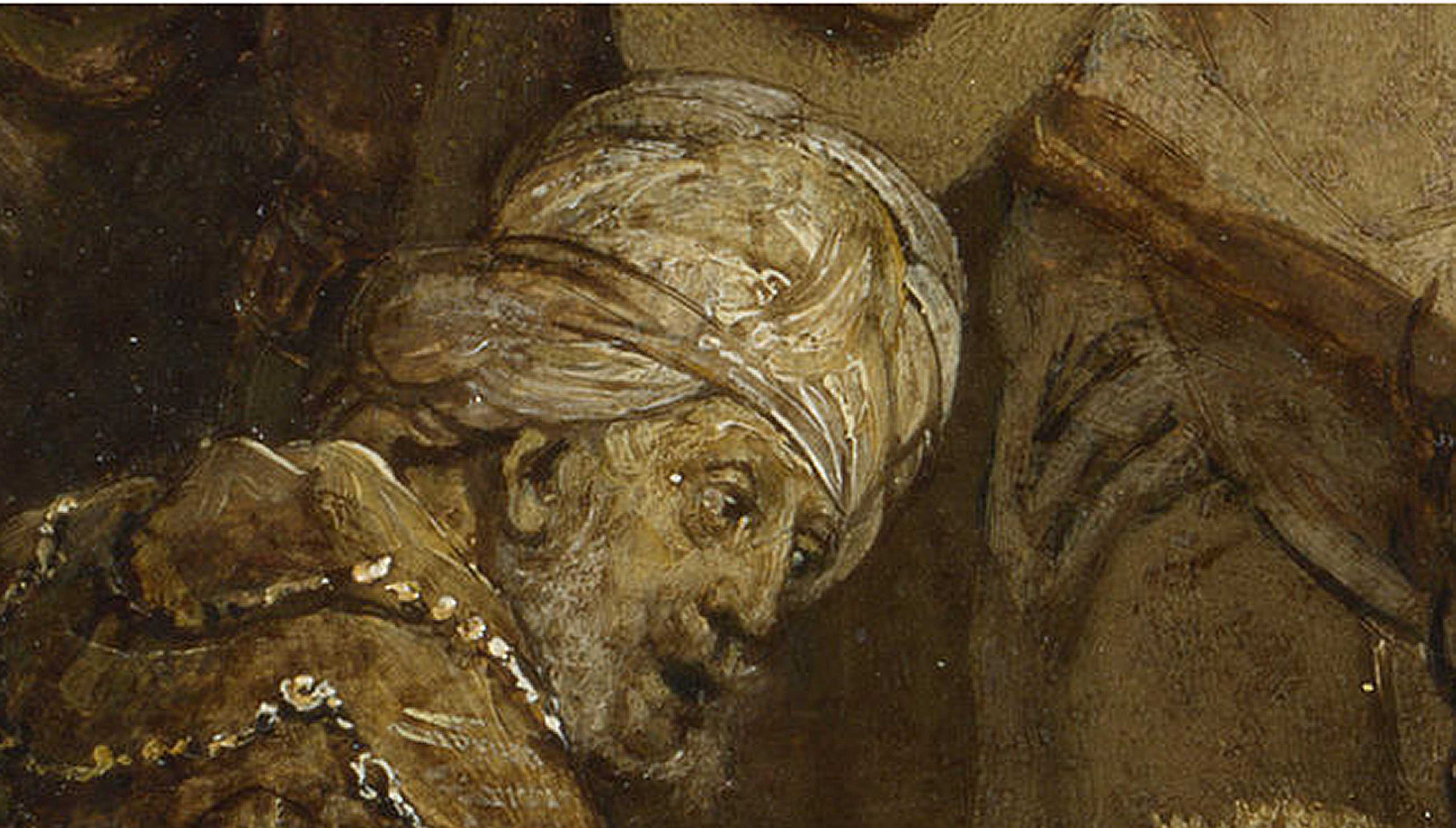
It is likely the translucent lead white was applied gently using sable or other soft brushes atop the asphaltum, which was merely "set" and not fully cured. From my own experience I know this can work quite effectively; and this is another advantage in using this historical transparent brown. Important! In the above and below Rembrandt details, notice the thicker pastose lead white used to highlight features. The brush easily ploughs through and sculpts the white lead, creating furrows that have remained perfectly upstanding through the centuries-- which is anything but typical of pure oil-and-pigment paint, alone, without a varnish-addition. Rather, the juicy paint is, instead, quite typical of turps-thinned and varnish-congealed lead white. I am fully aware our current chemist-researchers cannot detect the addition of varnish in Rembrandt's paint, but my own eyes "see" it, regardless. BTW, the white lead construct seems to be 'drowned' beneath a faint glaze of something either ocher-ish.... or perhaps a yellowed varnish coating?
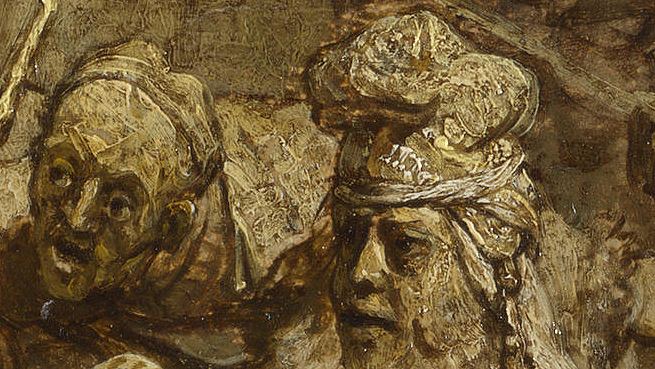
The following two images show Rubens' use of what is most likely spirit asphaltum, showing some 'optical grisaille' developement. The idea is to sketch the scene with asphaltum which offers the range of light and dark simply by its thin or thick application.
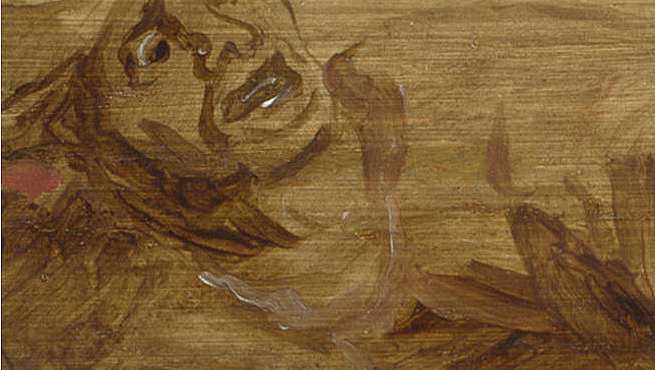
I should mention that Rubens journeyed to Italy and copied numerous Venetian works -- a plausible rationale for his seeming sometimes use of this "optical" modeling approach. Joshua Reynolds noticed Rubens' use of this mechanic atop the brown monochrome. Reynolds called it "heightening with white". Mentionable here is the visibly bare and 'raw' areas of asphaltum-- areas which do not appear to have been uniformly covered with the translucent coating of lead white. I might suggest these bare asphaltum sections were, indeed, given the thinnest of coatings, only to have eventually suffered the happenstance of lead white transparentizing in oil over time; or perhaps the master simply never attended to those areas-- these are, after all, unfinished works by Rubens.
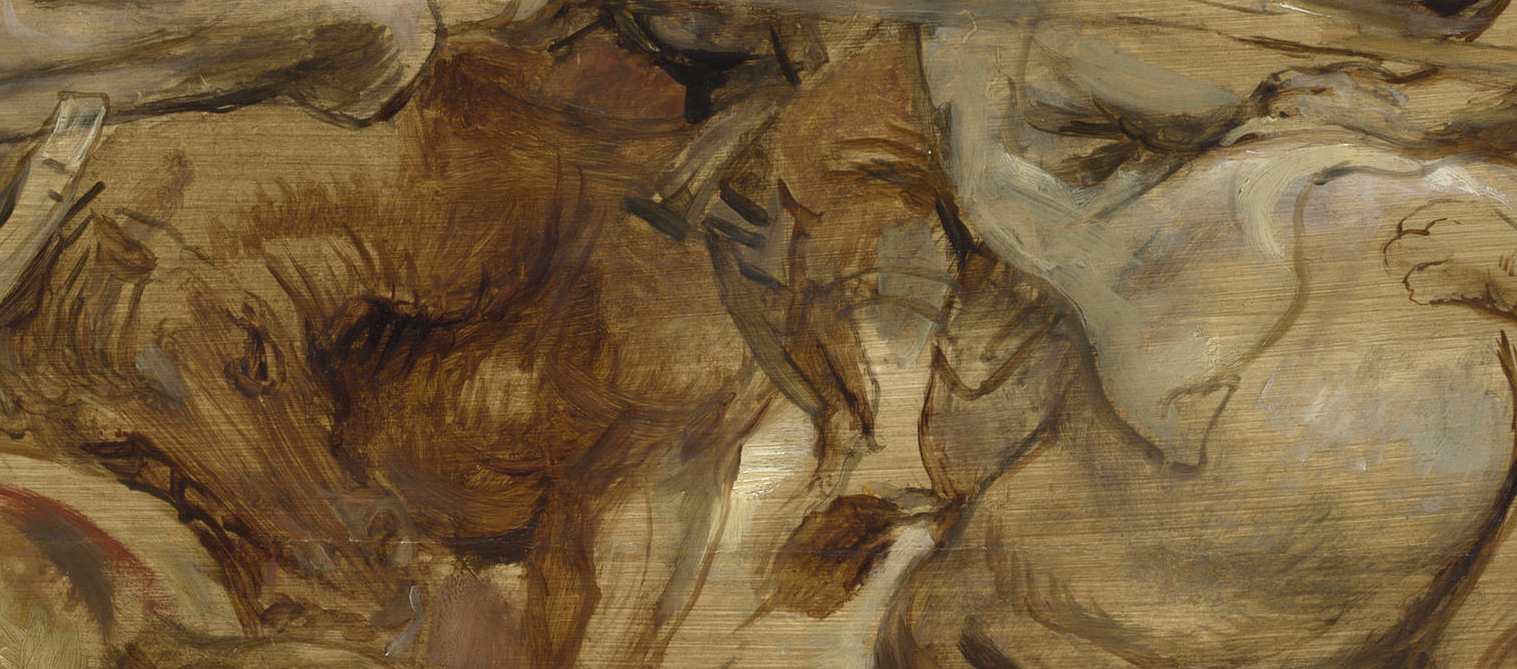
Below is another example. This is a detail from Rubens' "Coup de Lance". Be aware the color of the underlying imprimitur changes the relative tint of asphaltum within its thinnest applications:
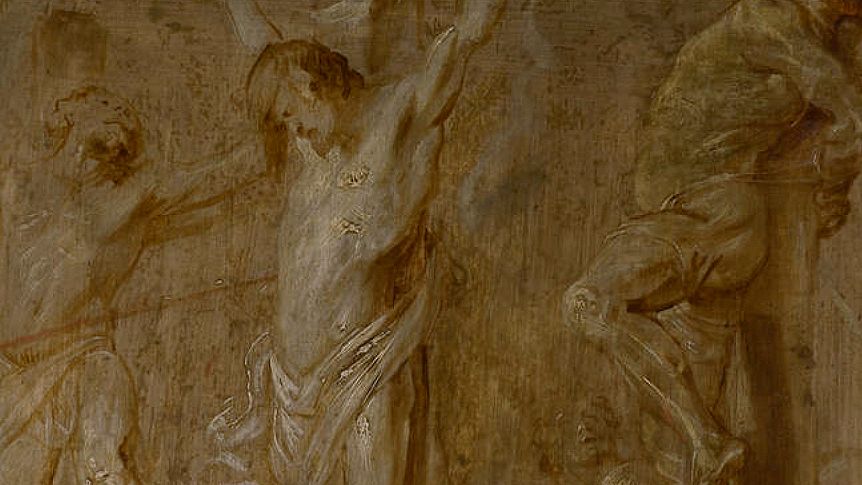
What follows below is a section of an actually colorized work by Rubens. The optical modeling in white atop the beasts is apparent; and, of course, the underlying asphaltum reveals itself everywhere. The apparent "optical grisaille" modeling has received various thin glazings of color, such as the obvious glaze of green. In the upper-left corner, an attempt of highlighting folliage with lead white is seen beneath the green glaze (an old Venetian construct, for certain-- see well below). Notice how Rubens' thin transparent paint allows a discerible 'keeping' of the brush-hatchings, plainly noticeable in his green glaze as well as his asphaltum-- a sure sign the master has added a paint-congealing varnish or medium to his colors. Mentionable again is the visually 'bare' asphaltum areas within the work which may be resultant from the thinner application and ultimate transparence of a once-intervening lead white film.
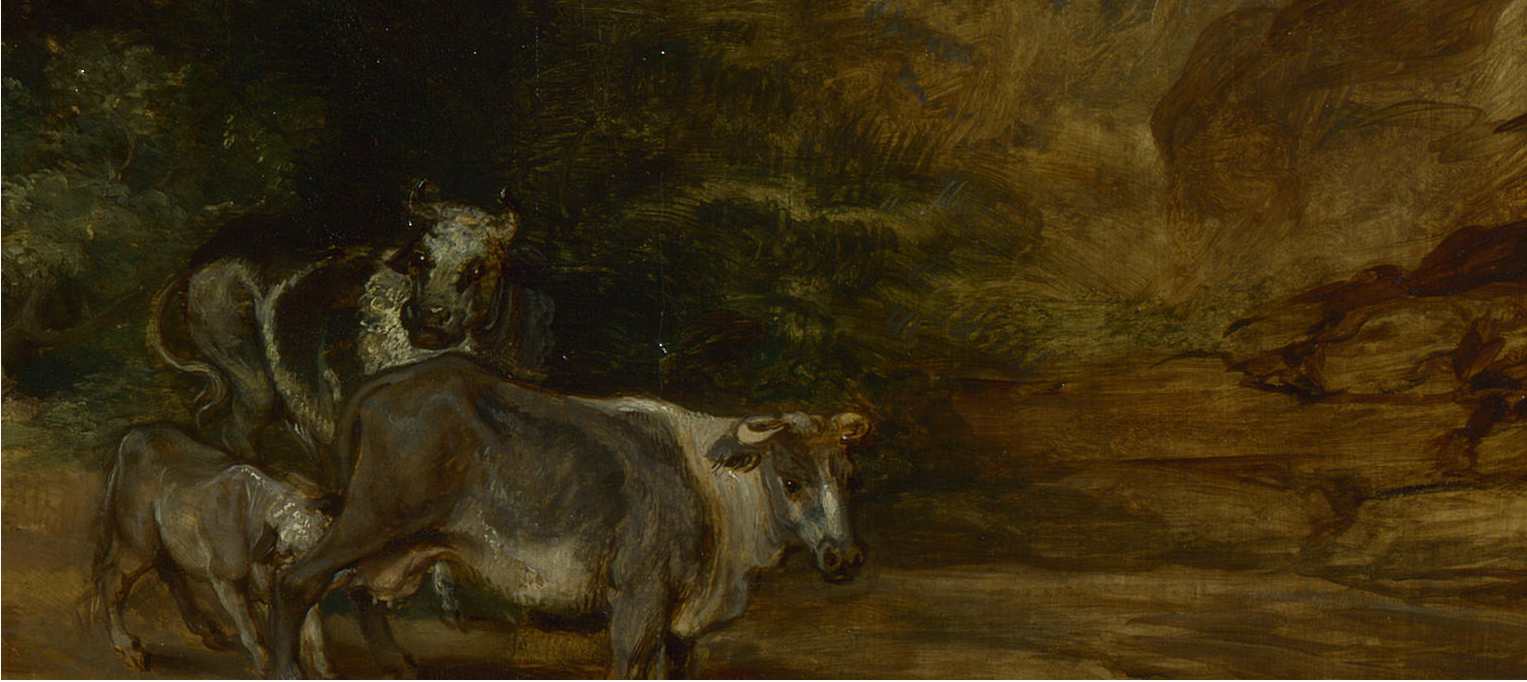
The Optical Grisaille in actual Demonstration and Practice
On the previous web-page introducing Fir Wax, I demonstrated the ability to superimpose' turpsy' washes in a manner similar to egg tempera. Herein, I shall now create a landscape utilizing what I call an optical grisaille methodology. The method performs exceedingly well with the landscape-- that is, if the right medium is incorporated into the paint
First, I mix Fir Wax with my spirit asphaltum (the formula for this paint is on the previous page); then I drip some turps onto the paint and re-mix with the knife to produce a soft facile easily brushed-out brown. I quickly build my "butte" scene using a soft filbert, which I dip into my turps every now and then when needed, stropping that 'wet' brush into the asphaltum, diluting that to whatever suitable viscosity I require. My darks are simply thicker applications or even over-applications of my juicy asphaltum. Very important (!): I work upon a sealed white ground. Also important: There is never any need to oil-out before beginning any layer.
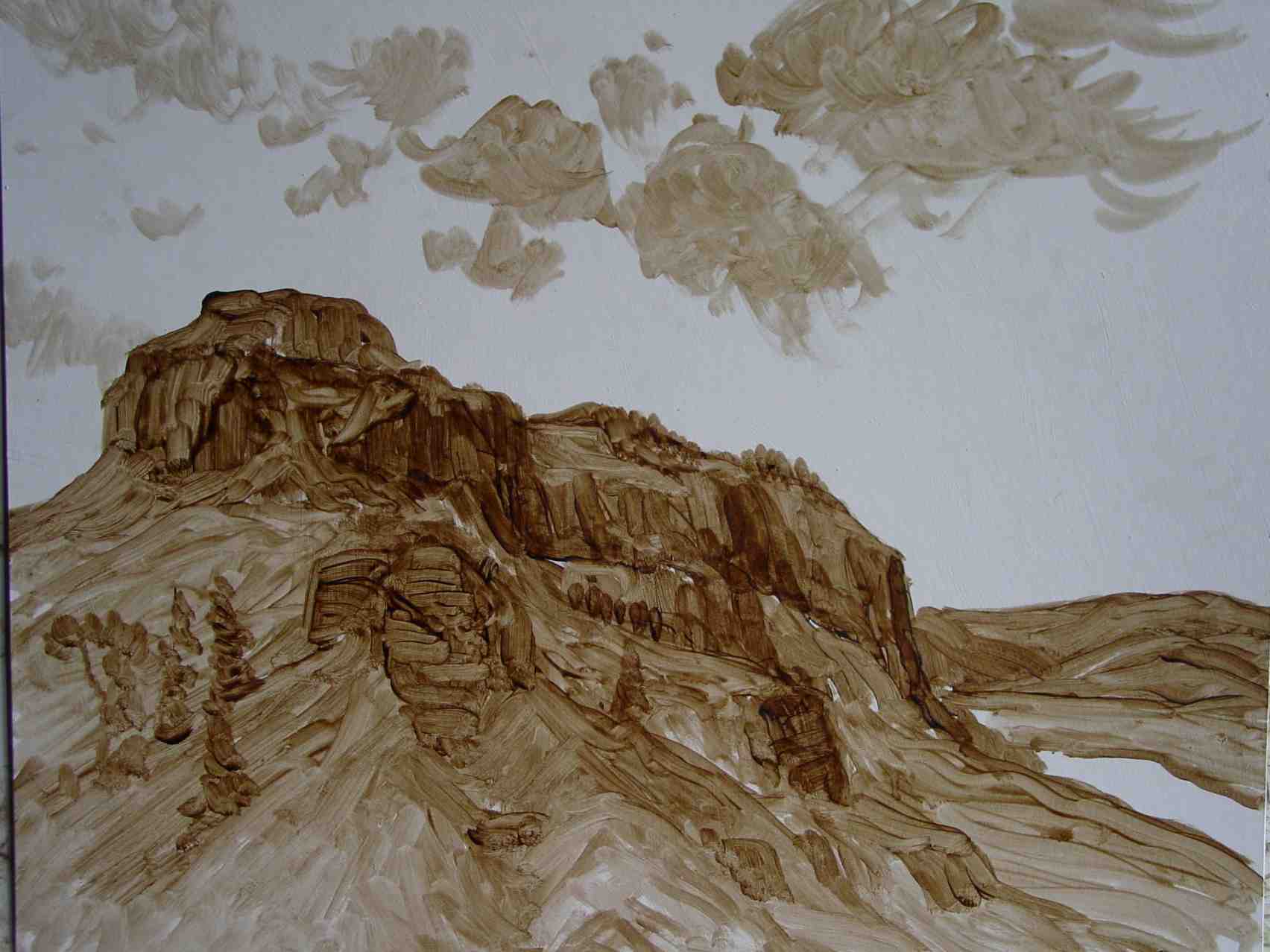
My monochrome asphaltum sketch developed, I allow the paint to set 30 minutes; then I mix-up some lead carbonate with nut oil to make a pasty lead white. I add about 30% Fir Wax to this white, which stiffens it, and requires the immixture of a good dose of turps to reduce it to a soft supple cream. Taking a wide filbert, I gently cover my asphaltum with the veil. Notice how my brown monochrome easily shines through the thin film of white lead, generating a faint but noticeable lilac coloring. Not so easily discerned by my camera is the faint orange and yellow. In similar to Rubens/Rembrandt, I apply the white much more thickly for my intended highlights, my brush plowing through the supple paint, sculpting it.
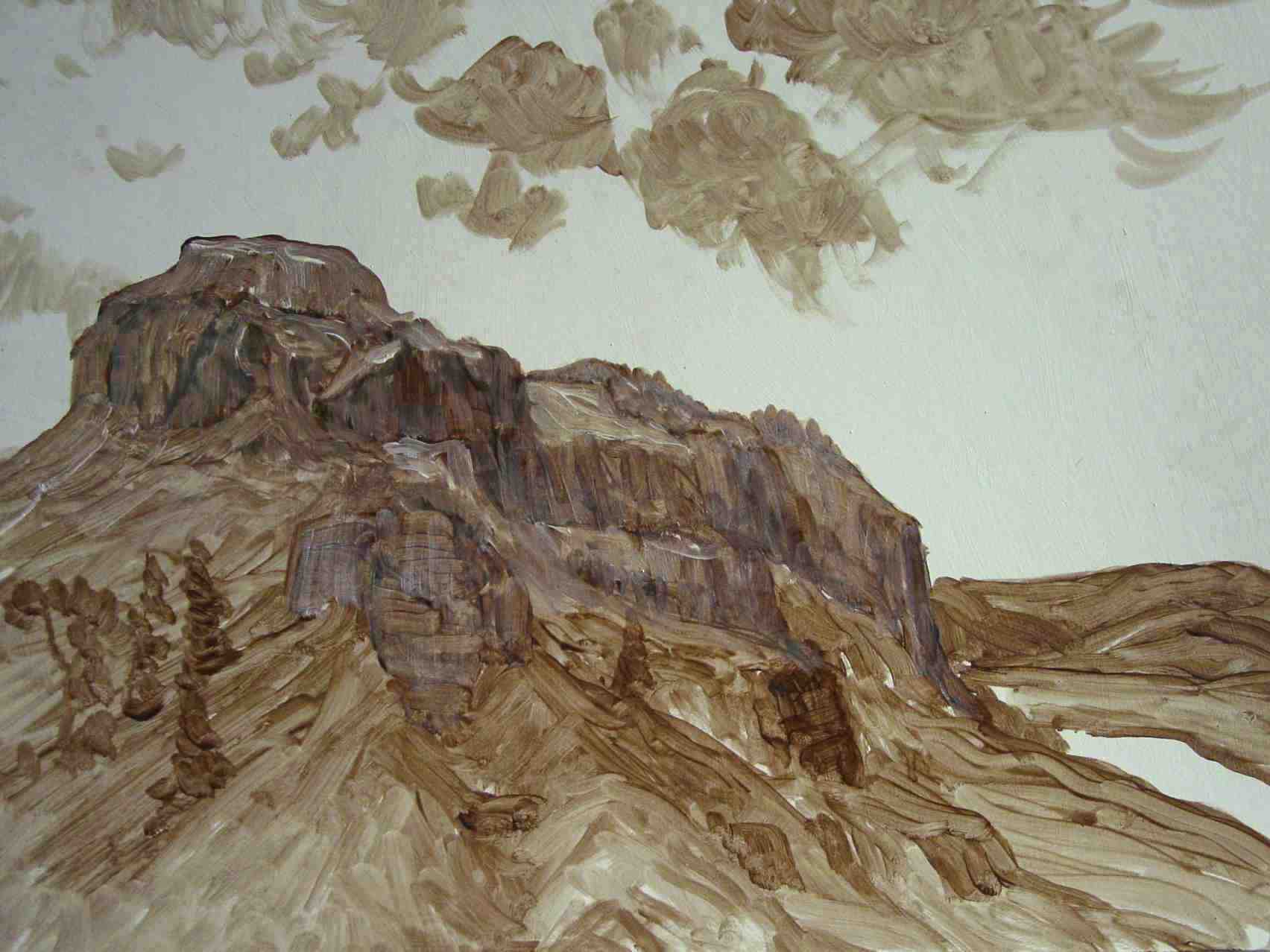
Below: My optical grisaille is complete to my satisfaction. It is important to also veil the sky.
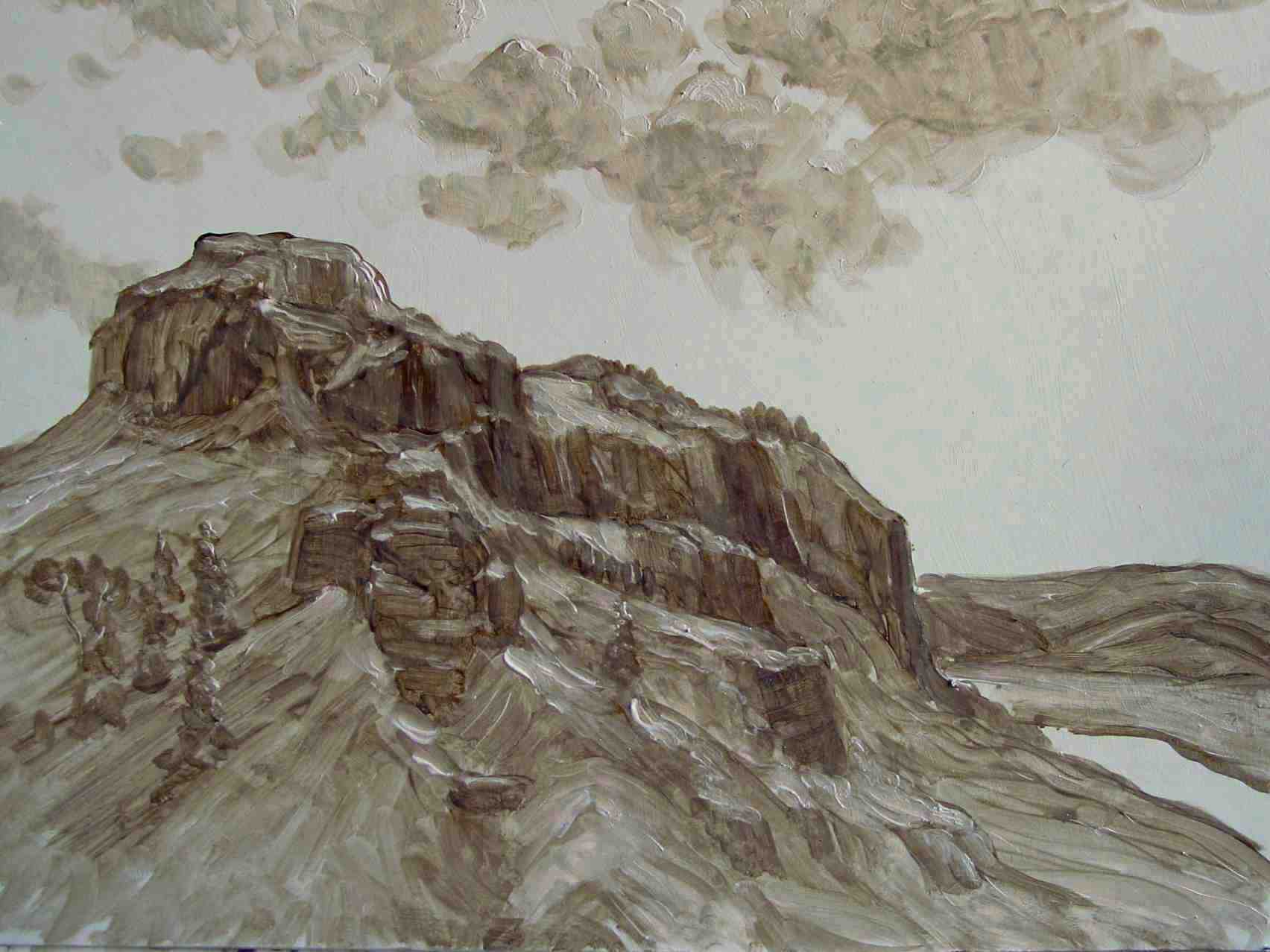
Below: The conjured "optical grisaille" has dried for a day; and now to begin the coloring. For the sky and distance I make up a light-blue mix of ultramarine and lead white-- both colors containing Fir Wax to further their transparency/translucency (equal amounts for the ultramarine and about 1/3rd for the white). I quickly brush this light blue mousse-like paint over my entire sky (yes, the clouds, too) area and also into my distant foothills. I pull the blue somewhat back to give the effect of descending sun-rays.
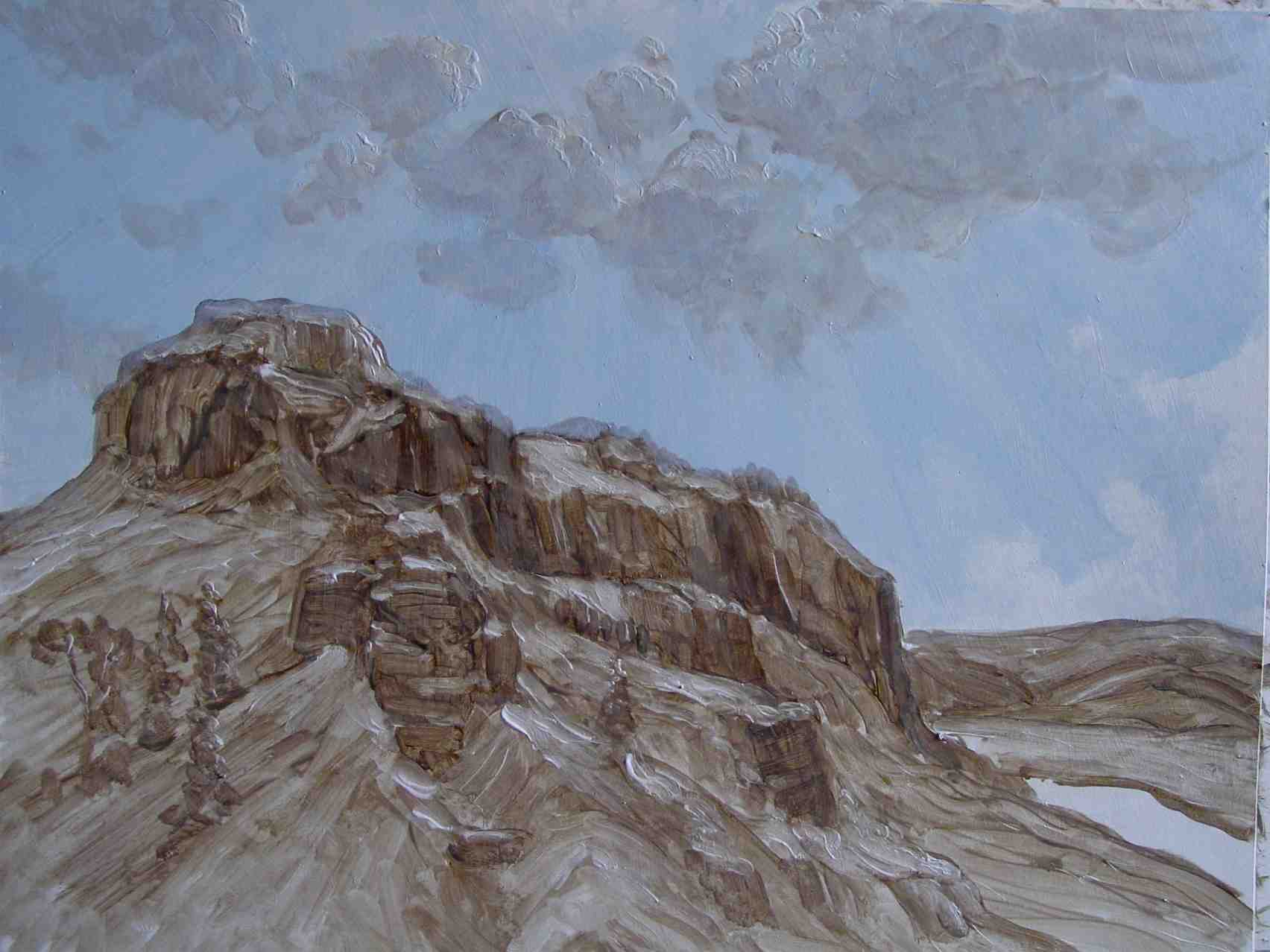
...going down into my distant foothills... adding in some iron red...
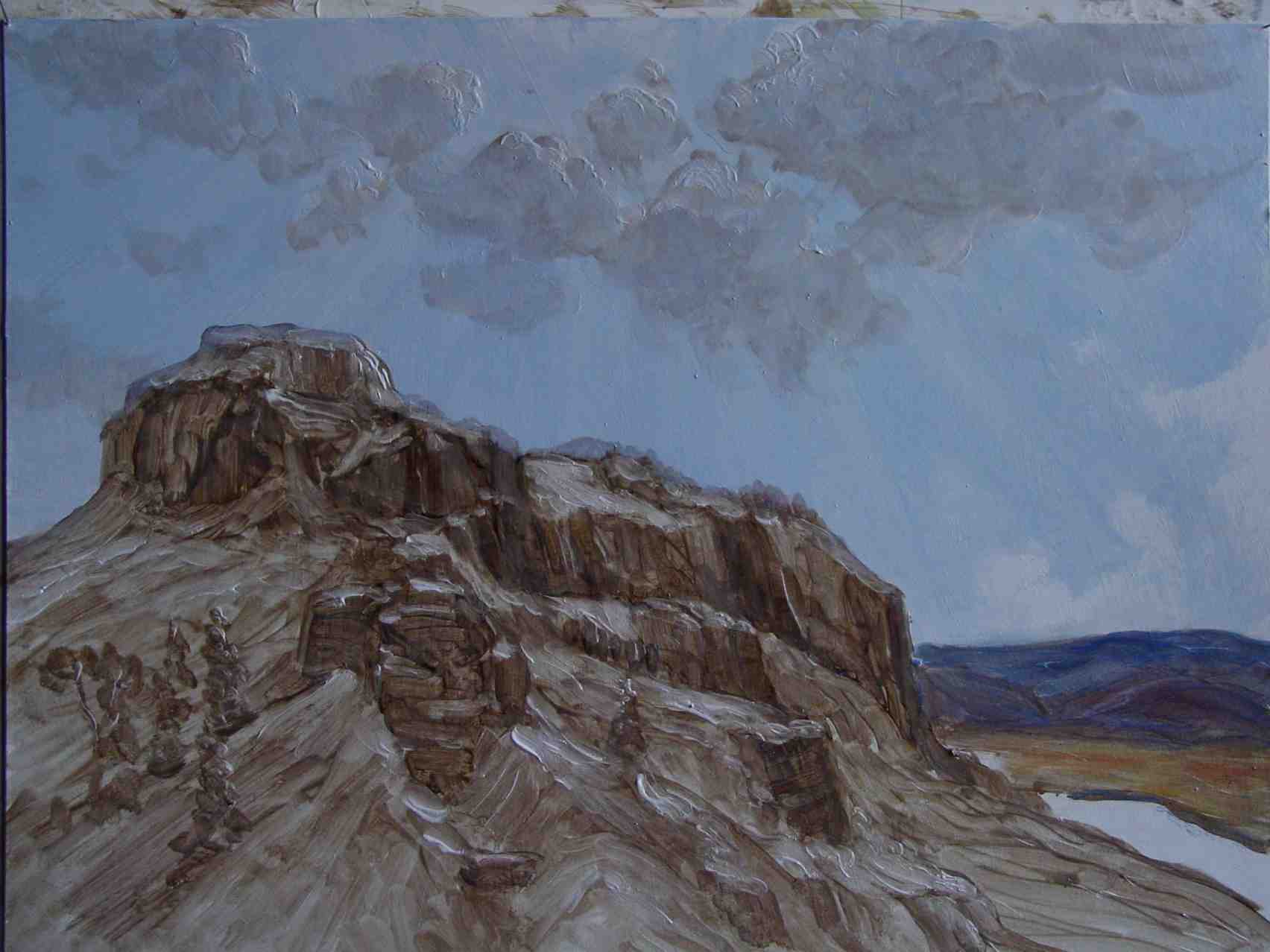
Next image: A closer look at the blue and iron red applied over the distant foothills....yellow-ochre and iron red for the plain.
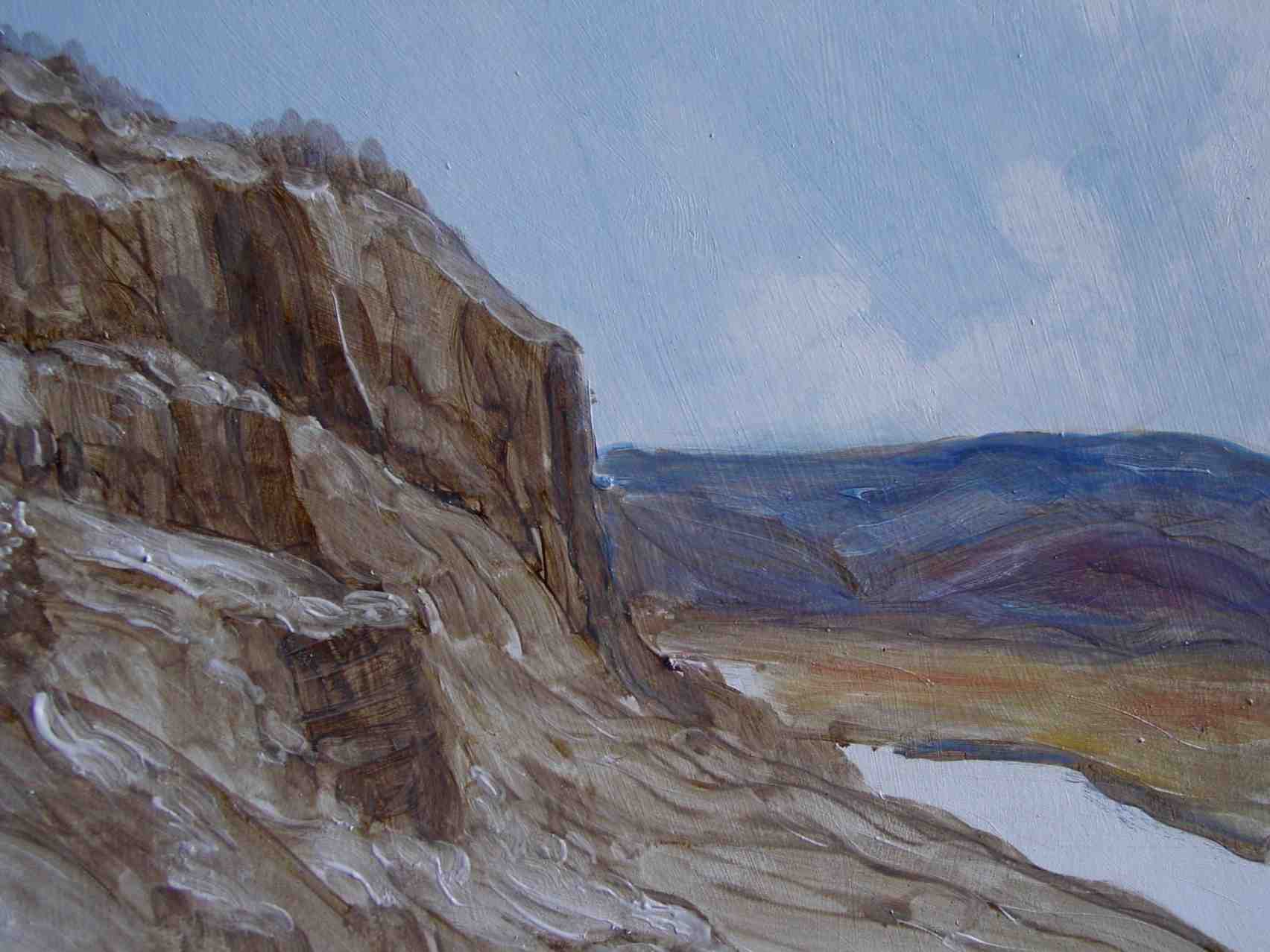
Now to wash-in some suitable shadow tint for my cliffs (AKA, local coloring). I'll go with a crimson mix of ult. blue and iron red softened with a faint titch of white....the white for aerial intervention.
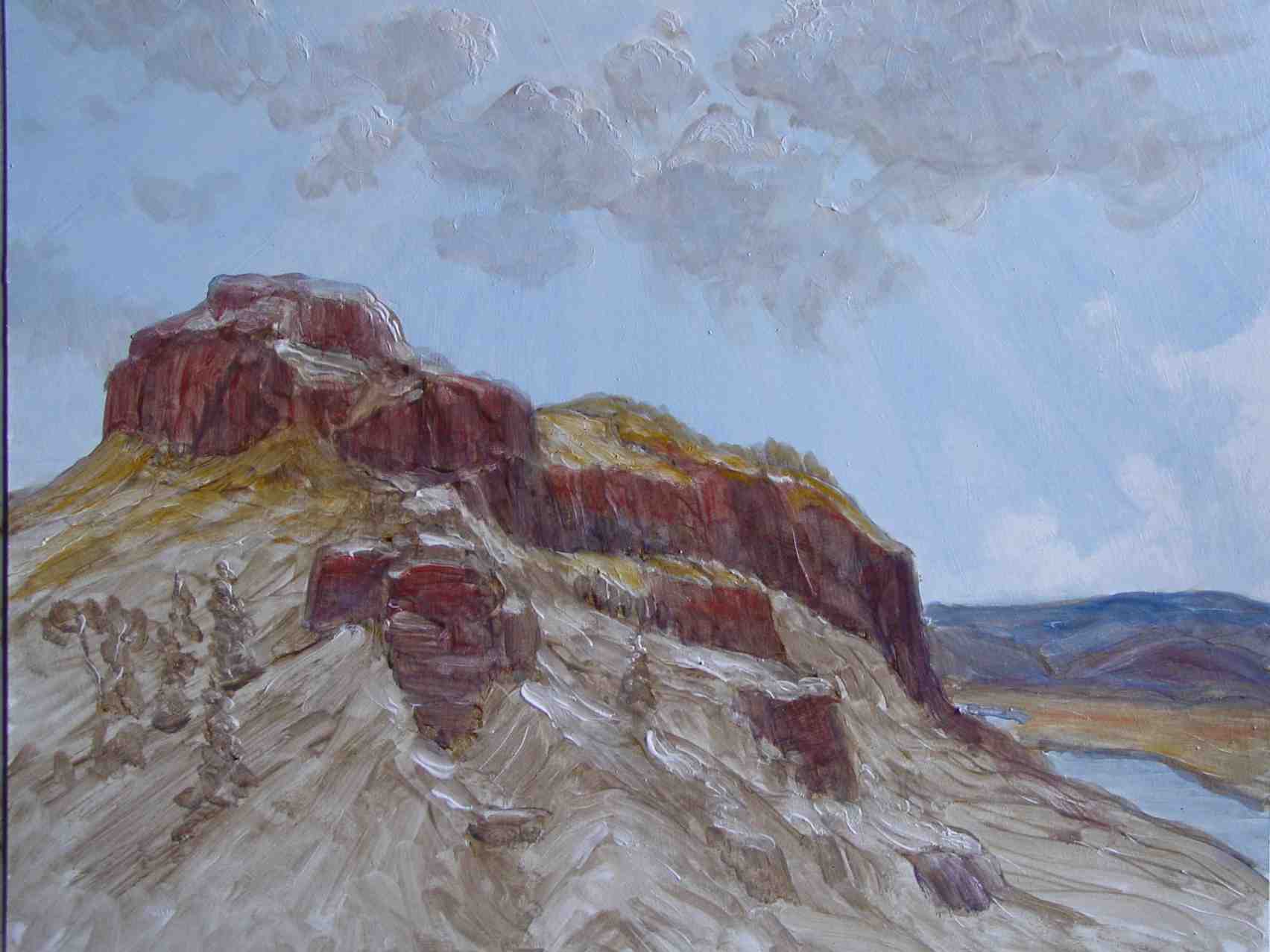
Below: Transparent greens and oranges applied over areas where vegetation occurs... As always, opaques shall come after broad glazings of local color. The underlying optical grisaille provides detail and contour showing through the transparent/translucent colorings.
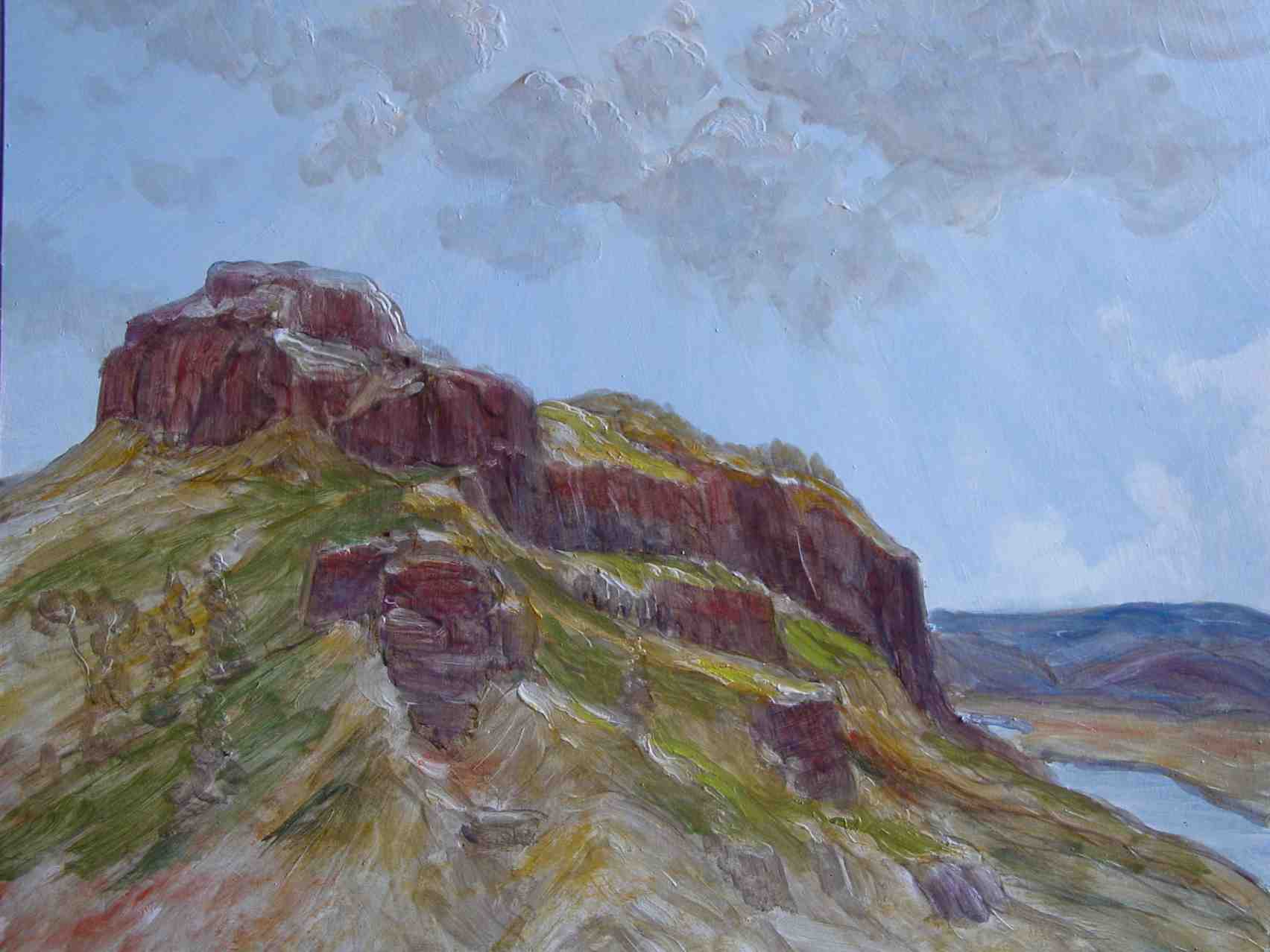
Opaque details are now touched-in on clouds and ground, wherever deemed fit. I could wait for my local coloring to dry before putting in these highlights, but I see no need. If I make a mistake, I'll just pull that off and go at it again. Opaques are typically my primaries mixed into white to produce light blue, light yellow ochre, light iron red. Add to these light greens, brighter reds/yellows for the foreground folliage or grass, whatever is needed. Now, consider, opaques are applied either thick or thin; it just depends on the brightness desired. For example, opaques can be applied into shadow areas thinly to produce half-lights; and in bright light, they are applied more thickly for highlights. Bright opaques inserted among glazed colors produce gem-like coloring. Physically, sensically, opaques provide a visual balance and feel of solidity to the overall mostly transparent/translucent painting.
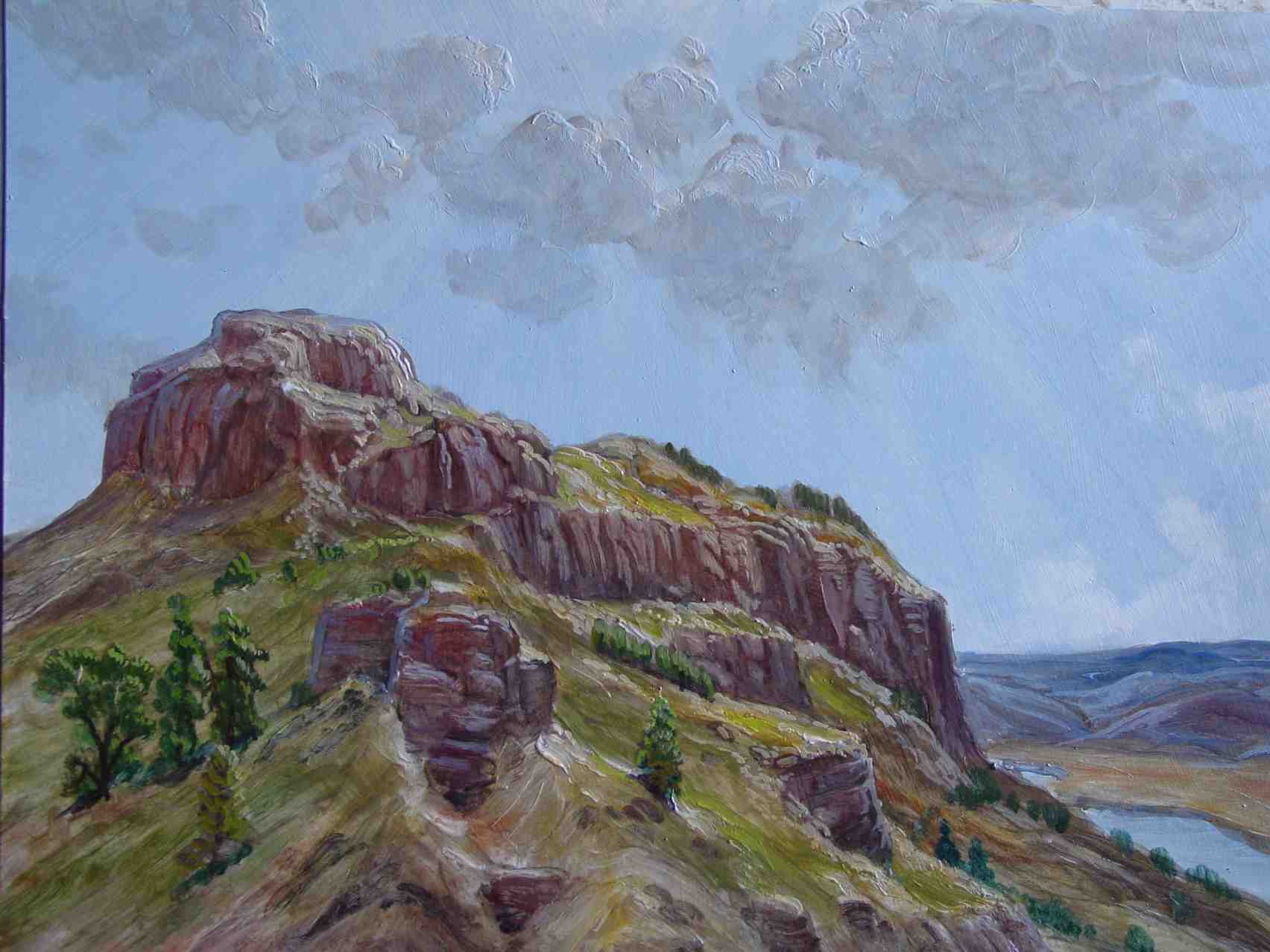
The final view photographed under daylight. The painting exhibits a high gloss finish without need of varnish. Note: Fir Wax is used in all my colors, not just the asphaltum. The reason for this addition is because I want all my colors to be used with turps. I also want my colors to dry at same general rate and with the same final sheen; plus the same strength and durability. Though I may alter the ratio of varnish with certain of my colors, it would make no sense to use the varnish in certain oil colors only; as long as those colors accept oil, they will also accept the Fir varnish. [Then again, as Eastlake reminds us ("Methods and Materials; Vol. I; chapter: "Preparation of colors"), certain often-utilized 'old master' colors-- such as carmine and verdigris-- needed varnish more than oil, as varnish provides better protection against damp than does oil; however, this does not mean varnish was not incorporated within other colors, too.]
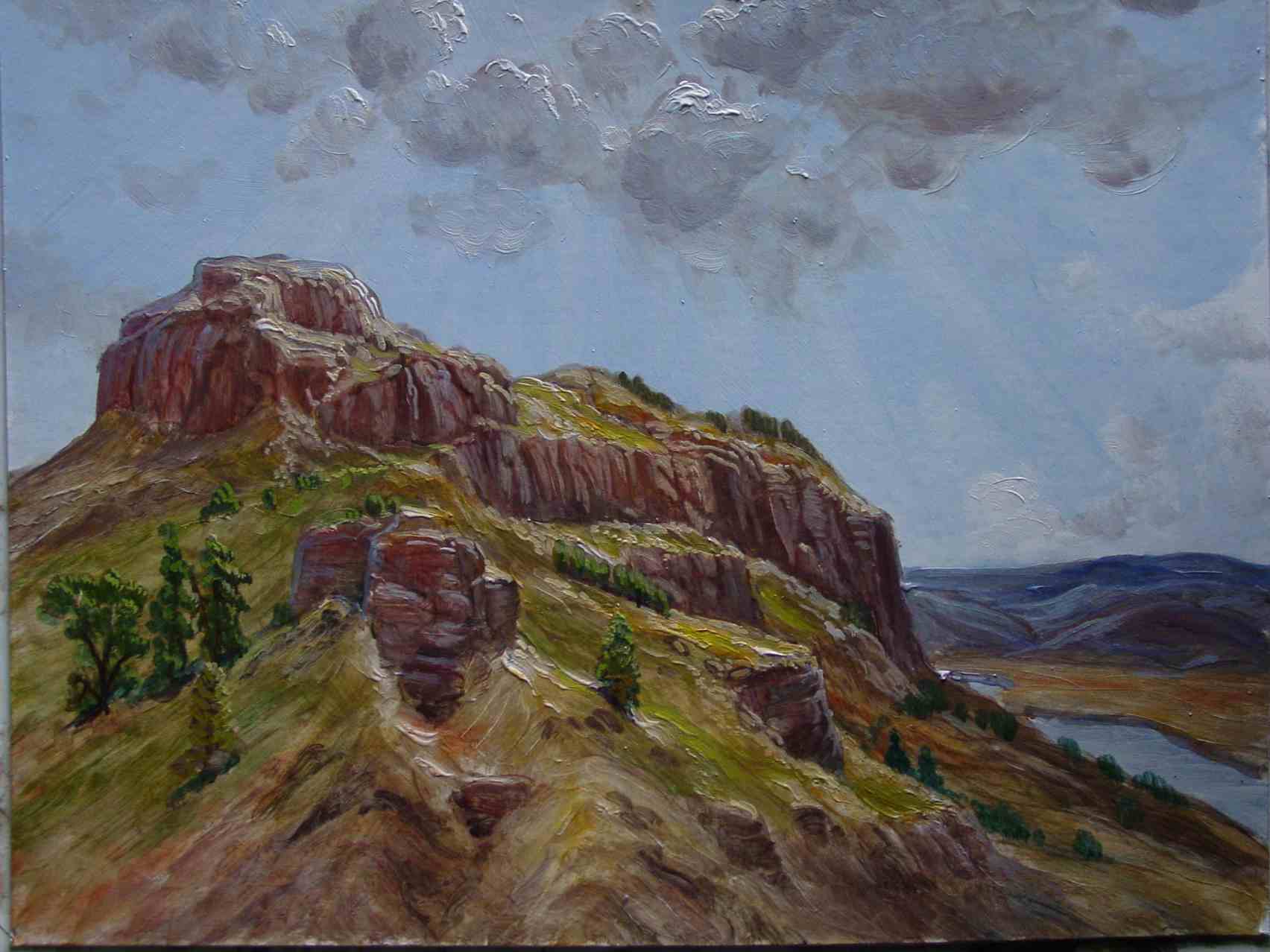
More Historical Examples of the Optical Grisaille
The following image shows an "optical grisaille" generated by Titian nearly a hundred years prior to the works, above, by Rubens and Rembrandt. In this National Gallery (Washington, DC.) painting, the elder Venetian painter has used lead white applied thinly/thickly (translucent in the shadows to full-impasto at the highlights) to construct a putto and other objects atop a brown-ish (black and iron red?) ground (which appears as a soft lilac in color due to the brown being given a thin covering film of white). This Titian is either unfinished or the glazed coloring has disappeared-- which can happen over time in a sun-filled land; and, as the historical word maintains, especially if only oil was used as the glaze-binder. There exists historical proof that thin glazes applied only with oil, and which have lost the final varnish protective coating, will simply oxidize away, the encompassing oil taking the colorant with it as it vaporizes away from the painting. [See Merrifield ("Medieval and Renaissance Treatises...") and her discussions with various Italian painters respecting the work of Titian. Instance: pages cxxxv and cxiv. ]
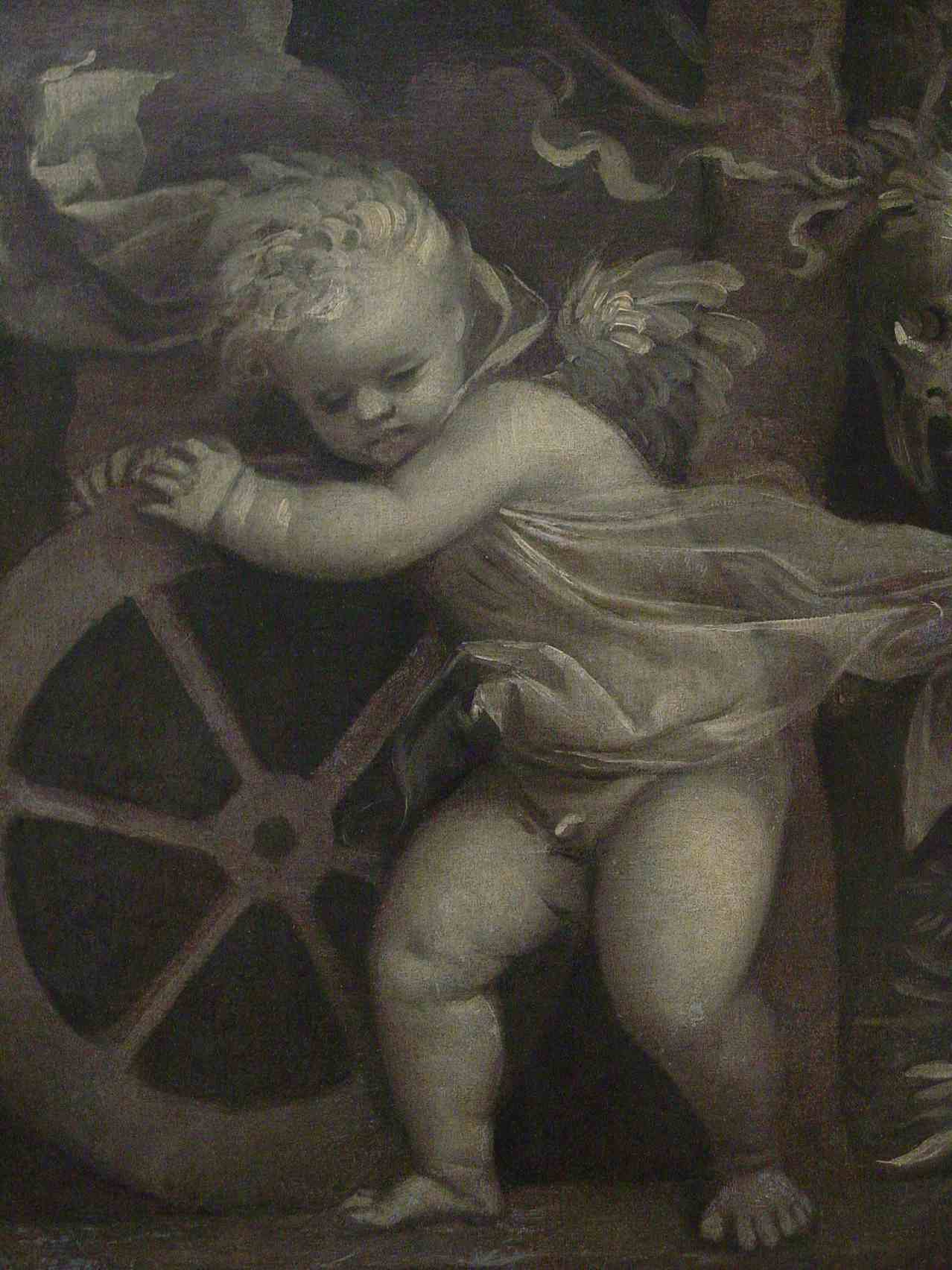
Below: A closer look at the piling-on of lead white paint in the brightest highlight. I hope you can see it. What appears as grey is, instead, thin translucent white. The actual overall modeling of the putto shown here is not a result of using various greyscale color-mixes; instead, it is all due to translucent-versus-opaque lead white application atop a semi-dark brown monochrome--and, repeating, a brownish ground is better than a black in the scheme towards luminous glaze/scumble coloring.
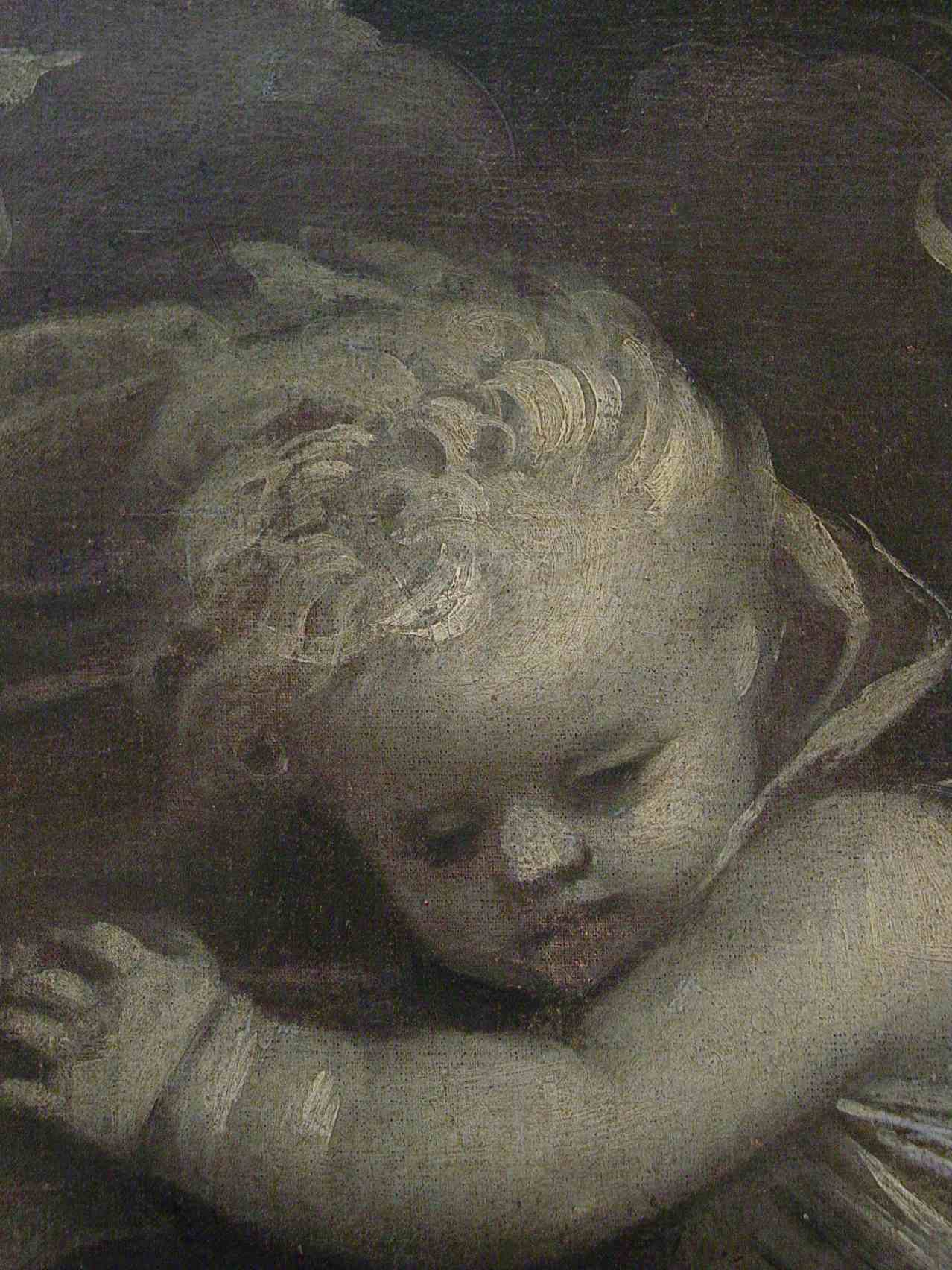
Below is another close-up of a Venetian work in the National Gallery, DC , painted by Giorgione. This shows very plainly the sketch in brown (asphaltum?) which was then modeled with only thin/thick applications of lead white paint to produce an "optical grisaille" of a tree and its folliage. After drying, two separate green glazes were applied to engender the full-color finale. Quite simple and very effective-- and all performed without need of multiple color-gradations mixed with paints upon the palette. As was mentioned above, Rubens may have noticed this sort of construct while undertaking his own Venetian copy-work.
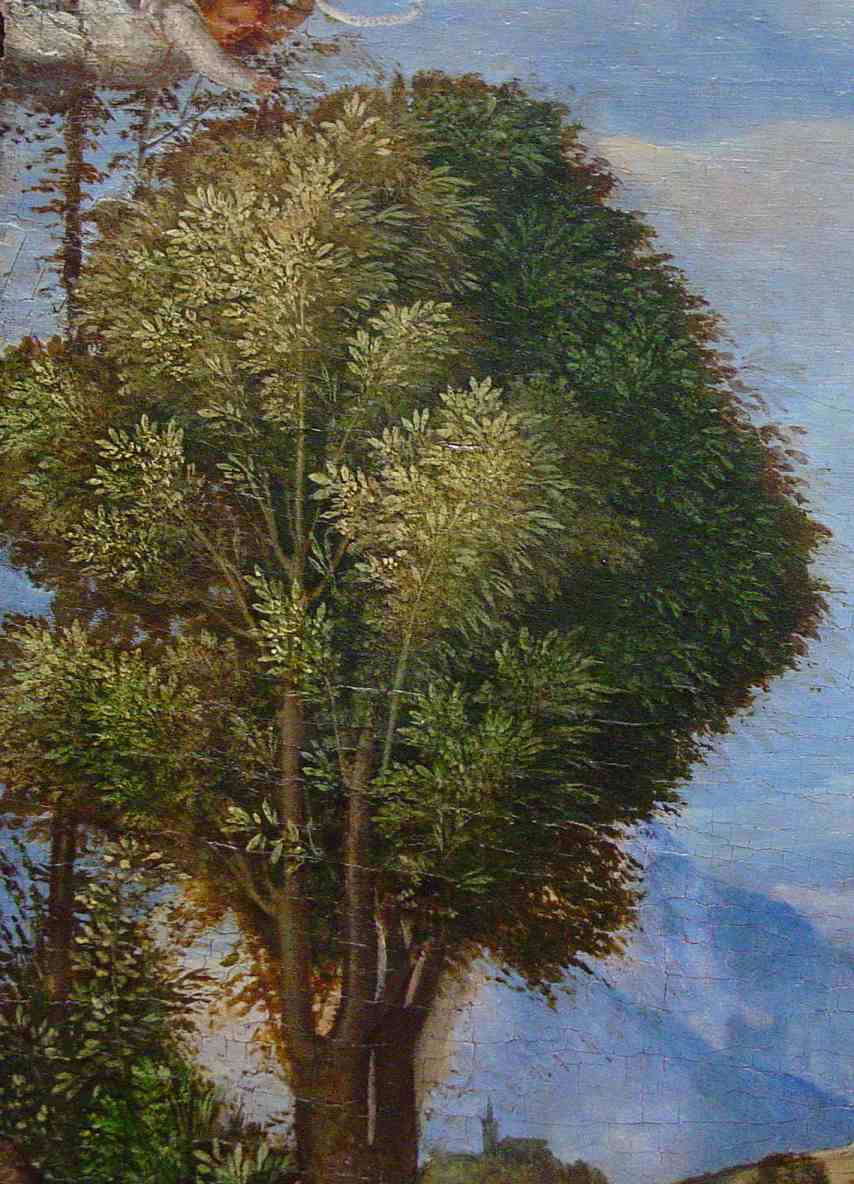
And below is an example of an "optical grisaille" plant-frond built of thin and thick white inserted into Frederick Church's "Morning in the Tropics" (also at the National Gallery in DC.). It seems to sport some faint glazings of irridescent earth orange, pink and purple; and though a hint of luminous emerald or yellow-green would seem to be called for, my camera is not picking that up. Stepping back from this large oil painting, the viewer may perhaps detect the overall and underlying optical grisaille foundation.
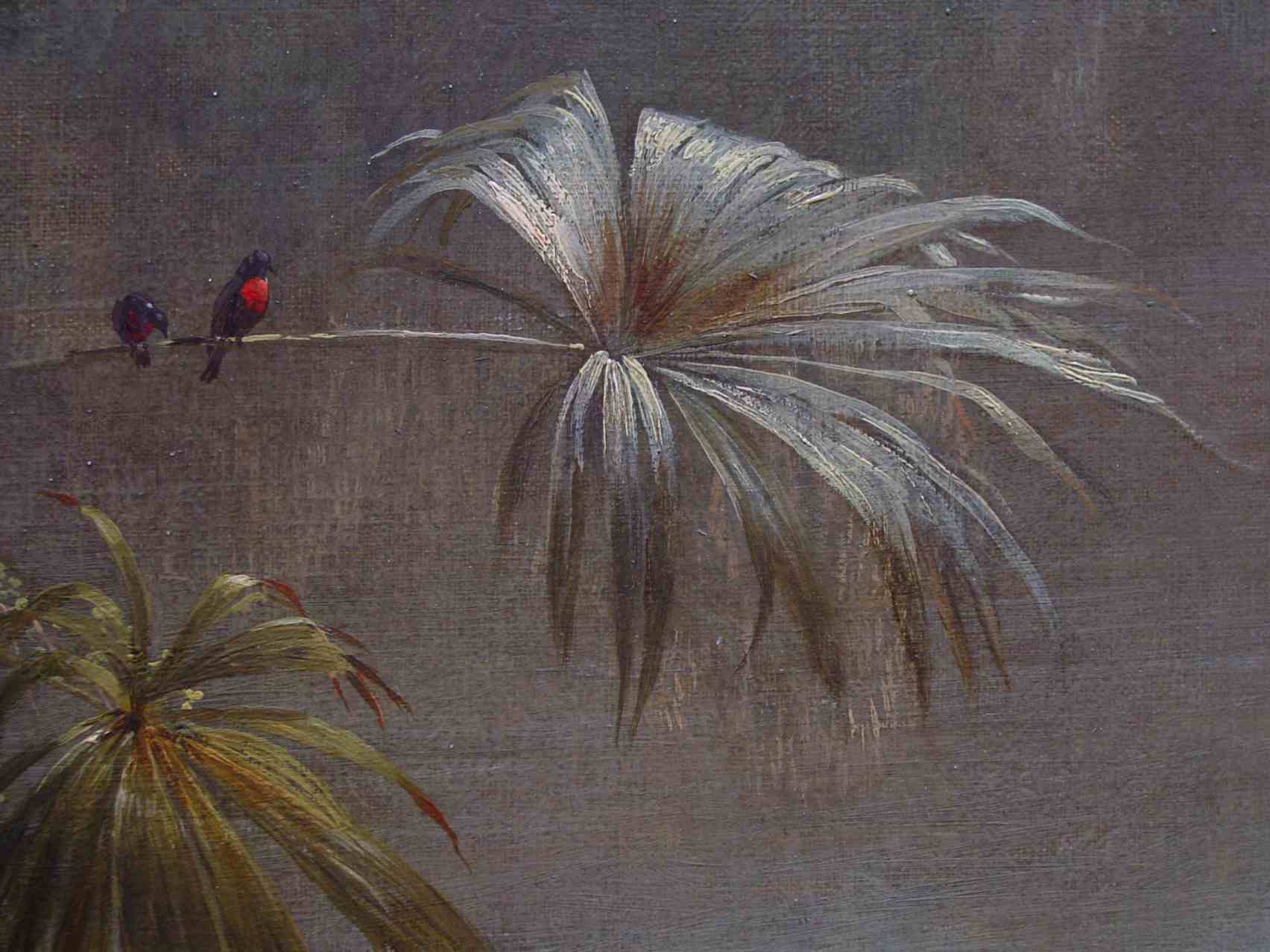
Eastlake VS the Venetian Secret
Other HR painters played with what I call the "optical grisaille" method; and Thomas Moran's later work certainly stands out-- though some of his creations developed upon a white under-modeling could strain the boundaries of natural color ("June, East Hampton", 1895, has a certain 'je ne sais quoi'). Charles Eastlake, who presented an interesting though confusing descript of the lost "Venetian system" within his posthumously-published second volume, might be credited as re-planting the seed for using an overall optical-layered approach-- certainly his second volume was widely read by the day's practicing painters. Eastlake seems to have derived his semblance of the manner from viewing Turner, who, in turn, begat his 'wax-y' attempts at the system from his own Venetian travels. Eastlake referred to the preparatory layering of a thin translucent film of lead white atop a dark monochrome as the production of "dynamic greys" which generated optical lilacs and subtle yellows and oranges. He does not direct the construction of a grisaille built with further heightenings of white; rather the dynamic grey was to be clothed in thin tones of brown suitable to the intended colors, such as light brown for blue areas; darker for red. The notion of "dynamic greys" as the possible basis of the Venetians appears to be the last realm Eastlake explored before his death. Still, soon after Eastlake's book entered the mainstream, very obvious attempts at unraveling the matter sprouted among many late 19th C. painters.
However...way, way back...in the mid-1460's, Antonio Filarete, an Italian sculptor and architect, described a 'new' oil painting technique. Filarete attributed the manner to the Northern painters, writing that Giovanni of Bruges (van Eyck) and others practiced it. Filarete wrote of gessoing a panel, sealing that with a layer of white, or even a tinted white, oil paint. After drying, a careful drawing of the intended design was performed atop the pure or tinted white paint. That careful drawing was then modeled in "shades of white" paint. After drying, the modeled construction was glazed with shadow-tints; then colored and highlighted. This is certainly an interesting descript of what could very well be an optical grisaille approach to oil painting. I'll have to admit, though, that the translated descript "shades of white" might also refer to mixes of black with white. [Further note: Filarete's descript implies linseed oil could be used to make the paints, though he professes not being familiar to matters concerning that oil. By contrast, his recounting of the painting method seems quite knowing. He writes the paint was allowed to dry after every stage. Be cognizant that in that early time, the invention of "Giovanni of Bruges" was held as a secret with few knowing Italian practitioners. Due to my own experience, I personally believe Filarte's painting process is both practical and sound. That said, and also due to my own experience, I believe a congealing resinous varnish is also a requirement for the best results.]
Copyright James C. Groves, Frostburg, Md. January, 2010
For Ordering Online click here
Click here to visit our Gallery page.